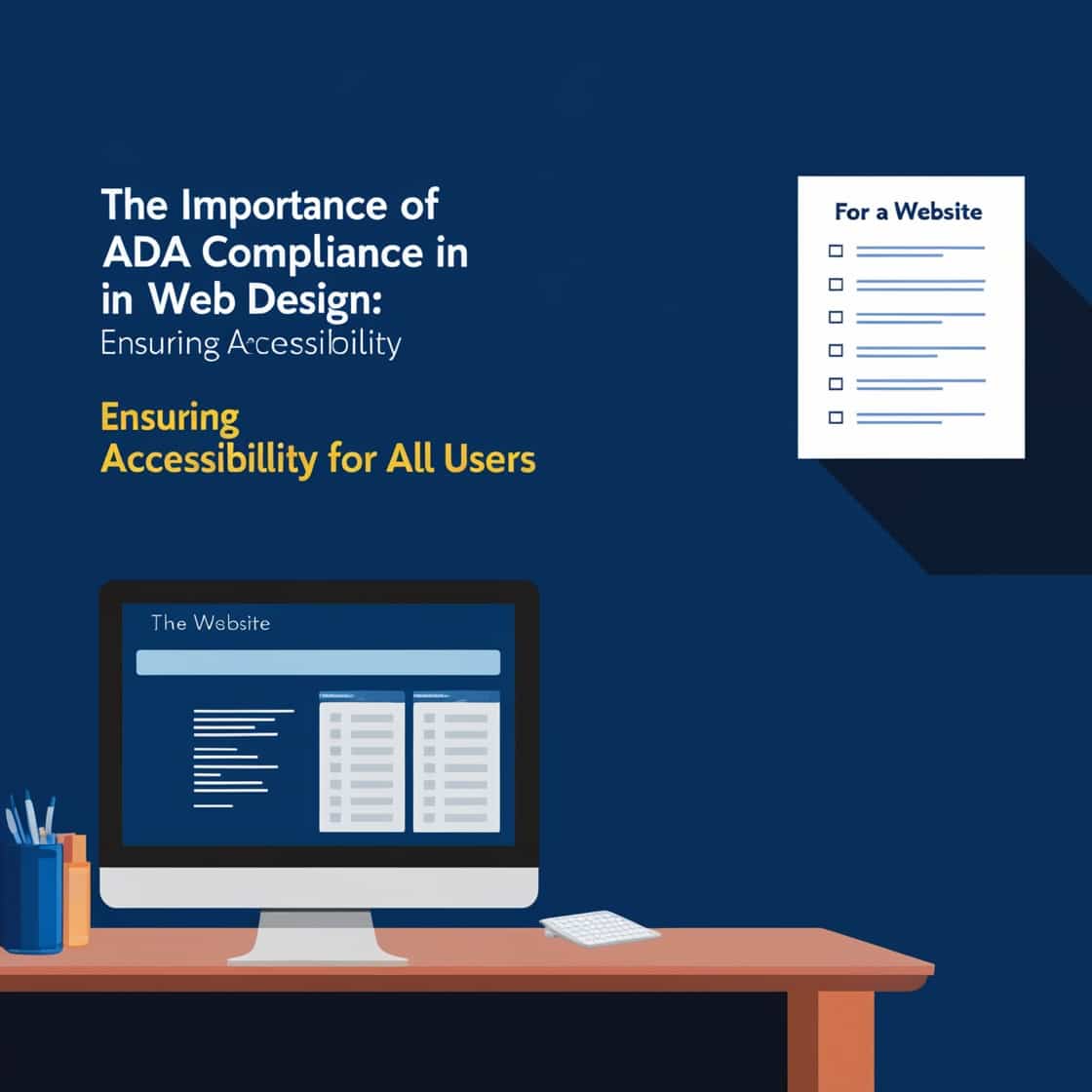Web accessibility is a critical aspect of website design that is often overlooked. Ensuring that websites are accessible to all users, including those with disabilities, is not only a moral obligation but also a legal requirement. The Americans with Disabilities Act (ADA) mandates that websites must be accessible to people with disabilities, including those who are visually impaired or have hearing impairments.
The importance of ADA compliance in web design cannot be overstated. Failing to comply with the ADA guidelines can result in legal action, including lawsuits and fines. In addition to the legal implications, making websites accessible to all users is simply good business practice. By designing websites that are accessible to everyone, businesses can expand their customer base and improve their online reputation.
In this article, we will explore the importance of ADA compliance in web design and provide practical tips for designing websites that are accessible to all users. We will discuss the legal requirements for ADA compliance, the benefits of accessible web design, and best practices for designing accessible websites.
Understanding ADA and Web Accessibility
Web accessibility is a crucial aspect of web design that ensures that people with disabilities can access and use websites. The Americans with Disabilities Act (ADA) is a federal law that requires businesses and organizations to make their websites accessible to people with disabilities. The ADA was enacted in 1990 to prohibit discrimination against individuals with disabilities.
The ADA requires that websites be accessible to people with disabilities, including those who are blind or visually impaired, deaf or hard of hearing, or have mobility impairments. This means that websites must be designed in a way that allows these individuals to navigate and use the site effectively.
To understand ADA compliance in web design, it is important to understand the principles of web accessibility. Web accessibility involves designing and developing websites that can be used by people with disabilities. This includes making sure that websites are compatible with assistive technologies such as screen readers, braille displays, and speech recognition software.
There are several guidelines and standards that web designers can follow to ensure that their websites are accessible to people with disabilities. One of the most widely used guidelines is the Web Content Accessibility Guidelines (WCAG), which was developed by the World Wide Web Consortium (W3C). The WCAG provides a set of guidelines for web designers to follow to ensure that their websites are accessible to people with disabilities.
Overall, understanding ADA compliance in web design is crucial for businesses and organizations to ensure that their websites are accessible to everyone, including individuals with disabilities. By following the guidelines and principles of web accessibility, web designers can create websites that are inclusive and accessible to all users.
The Importance of ADA Compliance
Ensuring ADA compliance in web design is of utmost importance for businesses that want to avoid lawsuits and demand letters. Public accommodations are required to comply with civil rights law, which includes providing equal access to individuals with disabilities.
Failing to comply with ADA regulations can result in costly legal battles and a damaged reputation for businesses. For example, in 2019, a major hotel chain was sued for failing to provide accessible websites and mobile apps, resulting in a settlement of $20 million.
Moreover, providing accessible web design is not just a legal requirement but also a moral obligation. It allows individuals with disabilities to access information and services that they would otherwise be denied, promoting inclusivity and equal opportunities.
To ensure ADA compliance, businesses should stay up-to-date with the latest regulations and guidelines. They should also conduct regular accessibility audits and usability testing to identify and fix any issues.
In summary, ADA compliance is crucial for businesses that want to avoid legal troubles, promote inclusivity, and provide equal access to individuals with disabilities.
Exploring WCAG Guidelines
Web Content Accessibility Guidelines (WCAG) are a set of guidelines that provide recommendations on how to make web content more accessible to people with disabilities. WCAG 2.0 is the current version of these guidelines, and it includes three levels of compliance: A, AA, and AAA.
Level A compliance includes the most basic and essential requirements for web accessibility, while Level AA compliance includes additional requirements that address more barriers to accessibility. Level AAA compliance includes the highest level of requirements and is considered the most difficult to achieve.
WCAG 2.0 guidelines cover a wide range of topics, including text alternatives for non-text content, keyboard accessibility, colour contrast, and more. These guidelines are designed to make web content more accessible to people with disabilities, including visual, auditory, physical, speech, cognitive, and neurological disabilities.
Web designers and developers can use these guidelines to ensure that their websites are accessible to all users, regardless of their abilities. By following these guidelines, web designers and developers can create websites that are more inclusive and accessible to everyone.
Overall, WCAG guidelines are an essential part of web design and development. By following these guidelines, web designers and developers can create websites that are more accessible to people with disabilities. This can help to ensure that everyone has equal access to information and services on the web.
Key Elements of Accessible Web Design
When designing a website, it’s important to ensure that it is accessible to everyone, including those with disabilities. In order to achieve this, there are several key elements of accessible web design that should be considered:
Navigation
Navigation is an essential aspect of web design, and it’s important to ensure that it is easy to use for everyone. This means that the navigation should be clear and consistent, and that users should be able to access all of the content on the site without any difficulty.
Headings
Headings are an important part of web design, as they help to structure content and make it easier to read. It’s important to use headings correctly, and to ensure that they are hierarchical and descriptive.
Images
Images can be a great way to enhance the visual appeal of a website, but it’s important to ensure that they are accessible to everyone. This means that images should have alt text, which describes the image for users who are visually impaired.
Video
Video content is becoming increasingly popular on websites, but it’s important to ensure that it is accessible to everyone. This means that videos should have captions or transcripts, which provide a text-based alternative to the audio content.
Colour and Contrast
Colour and contrast are important aspects of web design, as they can affect the readability of the content. It’s important to ensure that there is enough contrast between the text and the background, and to avoid using colour alone to convey information.
Alt Text
Alt text is a description of an image that is read by screen readers for users who are visually impaired. It’s important to ensure that all images have alt text, and that the alt text accurately describes the content of the image.
Captions and Transcripts
Captions and transcripts are text-based alternatives to audio content, and they are essential for users who are deaf or hard of hearing. It’s important to ensure that all videos have captions or transcripts, and that they are accurate and descriptive.
By considering these key elements of accessible web design, designers can ensure that their websites are accessible to everyone, regardless of their ability.
The Role of Assistive Technologies
Assistive technologies play a critical role in ensuring web accessibility. These technologies are designed to help people with disabilities interact with websites and digital content.
One of the most commonly used assistive technologies is a screen reader. Screen readers are software applications that read out the content of a website, allowing people with visual impairments to access the information. Screen readers can also be used to navigate the website, click on links, and fill out forms.
Another important assistive technology is keyboard navigation. Keyboard navigation allows people with mobility impairments to navigate a website using only the keyboard. This is especially important for people who cannot use a mouse or touchpad.
Assistive technologies are essential for ensuring that websites are compliant with the Americans with Disabilities Act (ADA). The ADA requires that websites be accessible to people with disabilities, and assistive technologies are one of the key ways to achieve this.
It is important to note that while assistive technologies are essential for web accessibility, they are not a substitute for good web design. Websites should be designed with accessibility in mind, using clear and concise language, descriptive alt text for images, and appropriate colour contrast. By combining good web design with assistive technologies, websites can be made accessible to everyone, regardless of their abilities.
Creating an Inclusive User Experience
Creating an inclusive user experience is a key aspect of web design that ensures that all users, regardless of their abilities, can interact with and understand the content on a website. Inclusive design aims to make websites perceivable, operable, and understandable for all users, including those with disabilities.
One way to achieve this is by ensuring that the website’s design is accessible to users with disabilities. This includes providing alternative text for images, using clear and easy-to-read fonts, and ensuring that the website is navigable using a keyboard. In addition, designers should consider using colour schemes that are easy to distinguish for users with colour blindness.
Another important aspect of inclusive design is making sure that the website’s content is written in plain language. This can help users with cognitive disabilities understand the information on the website. Designers should also consider using clear and concise language, avoiding jargon and complex terms that may be difficult for some users to understand.
Overall, creating an inclusive user experience is an essential part of web design. By making websites perceivable, operable, and understandable for all users, designers can ensure that everyone has equal access to the information and services provided on the website.
Legal Implications and Regulations
Web accessibility has become a crucial aspect of web design, and it is essential to understand the legal implications and regulations surrounding it. The Americans with Disabilities Act (ADA) is a federal law that prohibits discrimination against people with disabilities. Title II of the ADA applies to state and local government entities, while Title III applies to businesses that are open to the public.
In 2010, the Department of Justice (DOJ) published regulations that set standards for web accessibility under Title II and Title III of the ADA. These regulations are known as the 2010 ADA Standards for Accessible Design. The standards require that websites and web applications be accessible to people with disabilities, including those who are blind or have low vision, deaf or hard of hearing, or have mobility impairments.
Failure to comply with the ADA regulations can result in legal action against the website owner. In recent years, there has been an increase in lawsuits filed against businesses for failing to make their websites accessible to people with disabilities. The DOJ has also taken legal action against businesses that have violated the ADA regulations.
It is important to note that while there are no specific regulations for web accessibility under Title III of the ADA, the DOJ has stated that businesses must make their websites accessible to people with disabilities. The DOJ has also adopted the Web Content Accessibility Guidelines (WCAG) 2.0 as the standard for web accessibility. The WCAG 2.0 is a set of guidelines developed by the World Wide Web Consortium (W3C) that provides a framework for making web content more accessible.
In summary, web accessibility regulations are an essential aspect of web design. Failure to comply with these regulations can result in legal action against the website owner. Understanding the legal implications and regulations surrounding web accessibility is crucial for businesses that want to avoid legal issues and provide equal access to their websites for all users.
Evaluation and Tools for Compliance
To ensure that a website is ADA compliant, it is essential to evaluate the website and use appropriate tools. There are various evaluation tools available that can help web designers and developers to identify the accessibility barriers on their website.
One such tool is the WAVE evaluation tool, which is a free web accessibility evaluation tool provided by WebAIM. This tool can help identify errors on a website and provide suggestions for improvement. It can also generate a report that lists all the errors and warnings found on the website.
Another tool is the AChecker, which is a web accessibility evaluation tool that can evaluate web pages based on different standards and guidelines, including WCAG 2.0, Section 508, and BITV. The tool provides a detailed report that lists all the accessibility barriers found on the website.
In addition to using evaluation tools, there are also various resources available that can help web designers and developers to ensure that their website is ADA compliant. The Web Content Accessibility Guidelines (WCAG) 2.0 is one such resource. This document provides guidelines on how to make web content more accessible to people with disabilities. It covers a wide range of topics, including text alternatives, colour contrast, keyboard accessibility, and more.
Furthermore, there are various online courses and training programs available that can help web designers and developers to learn about web accessibility and how to ensure that their website is ADA compliant. These courses cover topics such as accessibility testing, accessibility design, and accessibility coding.
Overall, it is essential to evaluate a website and use appropriate tools and resources to ensure that it is ADA compliant. By doing so, web designers and developers can ensure that their website is accessible to everyone, including people with disabilities.
The Impact on Business and Brand
Ensuring ADA compliance in web design can have a significant impact on a business and its brand. Non-compliance can result in legal action, loss of customers, and damage to the company’s reputation.
Businesses that fail to comply with ADA regulations risk facing legal action, which can result in costly fines and legal fees. These legal actions can also damage a company’s reputation and brand image. By contrast, companies that make an effort to comply with ADA regulations signal to customers that they are committed to inclusivity and accessibility.
In addition to the legal and reputational risks, non-compliance can also result in lost customers. According to a survey conducted by Click-Away Pound, 71% of people with disabilities will leave a website that is not accessible. This can translate to a significant loss of potential customers and revenue for businesses.
On the other hand, companies that make their websites accessible can tap into a market of over one billion people with disabilities worldwide. By prioritising accessibility, companies can create a positive brand image and increase their customer base.
In summary, ensuring ADA compliance in web design is crucial for businesses to avoid legal action, protect their brand image, and retain customers. By prioritising accessibility, companies can also tap into a large market of people with disabilities, creating a positive brand image and increasing revenue.
Future Trends and Developments
As technology advances and the digital world evolves, it is essential for web designers to stay up-to-date with future trends and developments in accessibility. With the growing importance of web accessibility, it is expected that there will be a continued focus on creating websites that are inclusive for all users.
One of the future trends in web accessibility is the use of artificial intelligence (AI) to improve the user experience. AI can help identify accessibility issues and suggest solutions to make websites more accessible. This technology can also assist users with disabilities by providing alternative ways to interact with websites.
Another trend in web accessibility is the use of virtual and augmented reality (VR/AR) to enhance the user experience. These technologies can provide a more immersive and interactive experience for users. However, it is important to ensure that these technologies are accessible to users with disabilities.
In the future, there will also be a continued focus on creating websites that are mobile-friendly and responsive. With the increasing use of mobile devices, it is essential that websites are designed to work well on smaller screens and touch-based interfaces.
Moreover, web designers will need to keep an eye on the development of new web technologies and standards. This includes the ongoing development of HTML, CSS, and JavaScript, as well as the adoption of new web standards such as Web Content Accessibility Guidelines (WCAG) 3.0.
As the digital world continues to evolve, it is essential for web designers to stay informed about future trends and developments in web accessibility. By doing so, they can create websites that are inclusive for all users, regardless of their abilities or disabilities.







